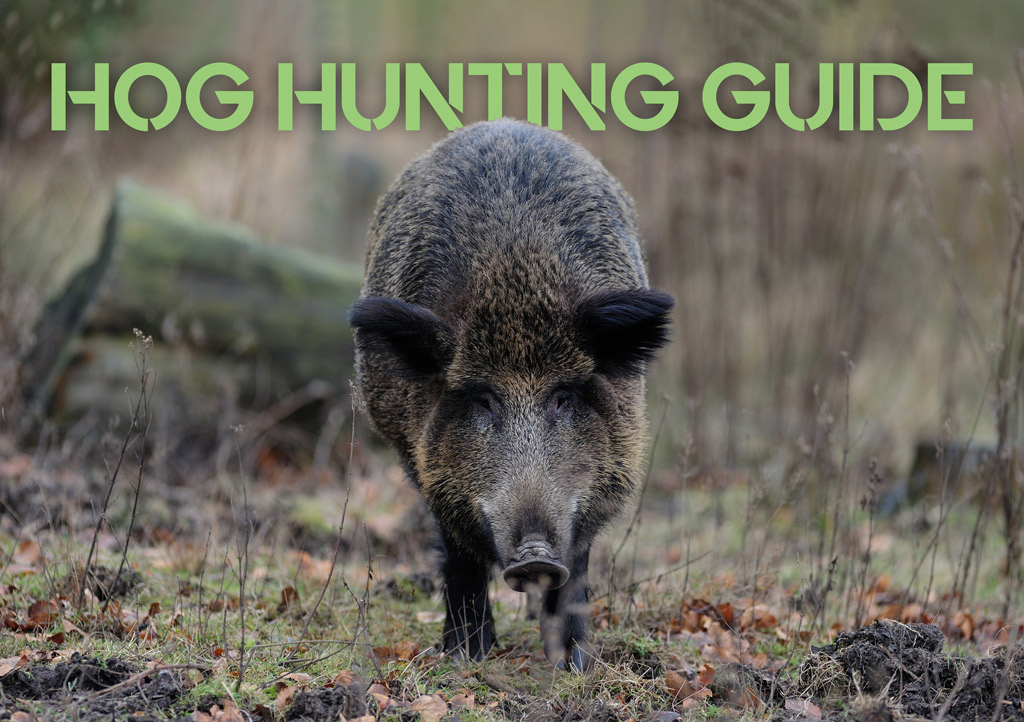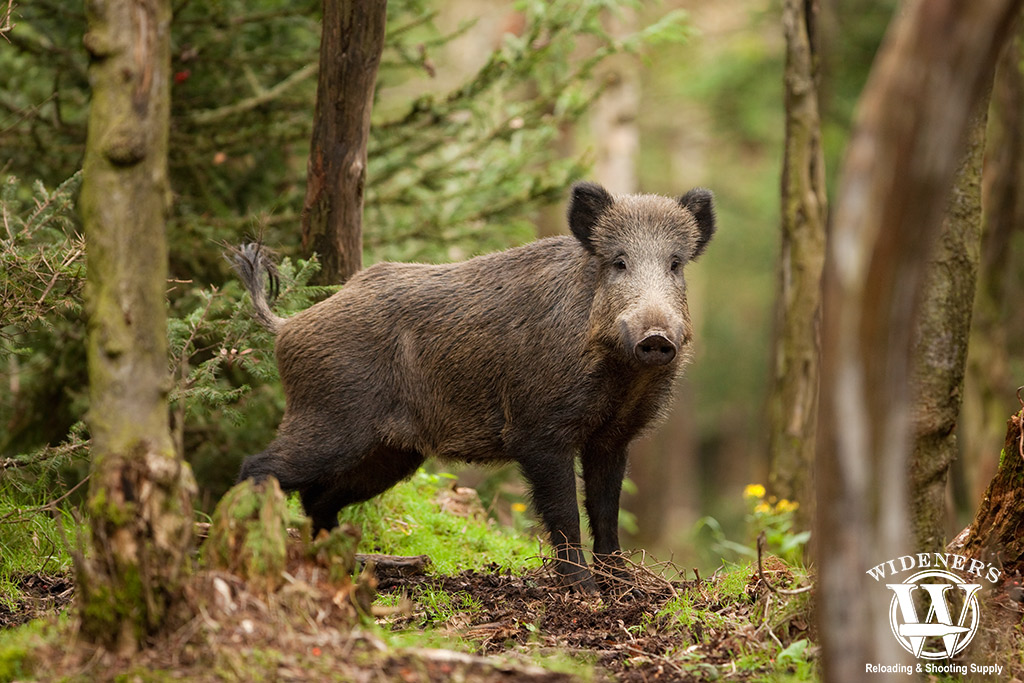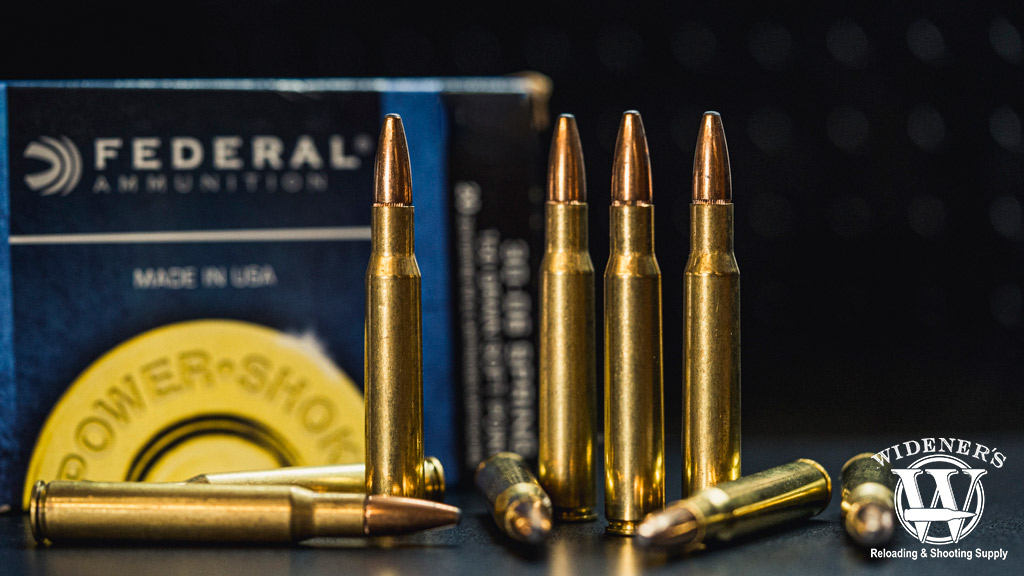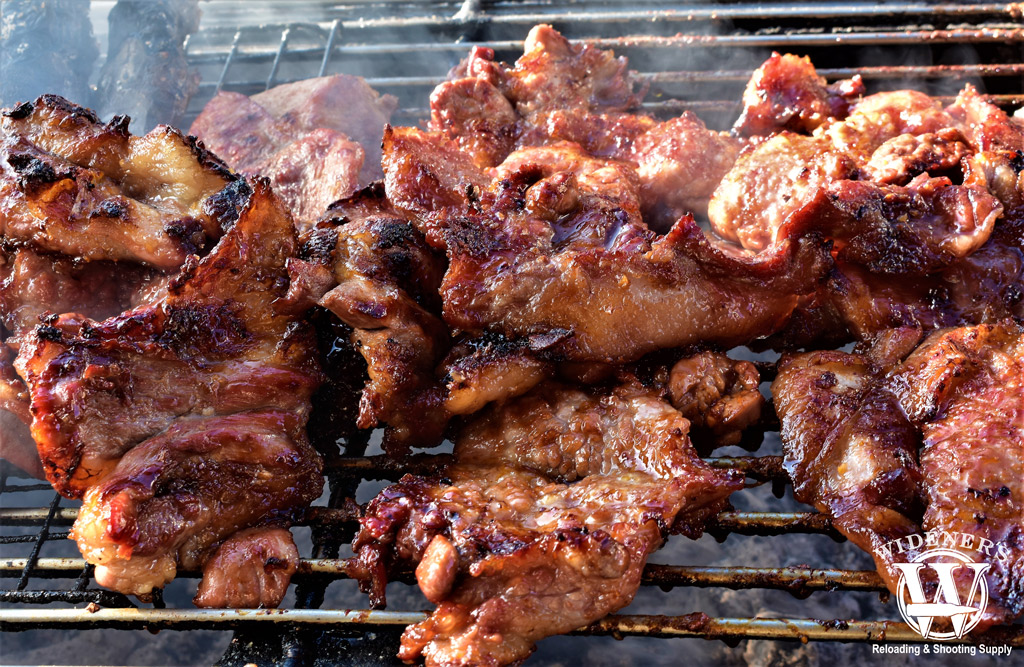

More and more hunters are curious about the hog hunting craft. But where should you start? If you’re new to hog hunting, this guide will give you the meat and potatoes to get started.
The wild hog population is growing every year, leading many states to categorize them as invasive pests. Landowners and farmers are frustrated with wild hogs damaging their property and livestock. This demand to reduce the hog population has given hunters many exciting opportunities.
Let’s talk about the when, where, and how of hog hunting.
Why Wild Hog Hunting?
People choose to hunt wild hogs for all sorts of reasons. In this section, we’ll detail some of the benefits of hunting wild hogs.
Here they are:
- Wild hogs are destructive. Often, wild hogs are incredibly destructive to farmers’ crops and landowners’ private property. For this reason, hunters must keep populations under control.
- Wild hogs are growing in number. Coyotes and mountain lions hunt young hogs; however, many adult hogs live with little fear of predation. Also, hogs breed all year long, leading to rapid growth.
- Wild hogs are good-eating. Feral hogs taste similar to regular pigs, and if you bag a large one, you have a lot of meat in the freezer. No doubt, hunting hogs is a good way to keep food on the table.
- Long-lasting season. In many states, you can hunt hogs all year. This lets you scratch that hunter itch before chasing the big buck next year. Some areas are quite generous with hog bag limits and hunting licenses.
Now, let’s figure out how to hunt these beasts.
How To Hunt Wild Hogs
Before we jump too far into the woods, let’s start with a list of sections we’ll cover. You’ll be able to refer to this when you need to review it.
Steps to hunting hogs:
Time to get started.
Hog Knowledge

Feral hogs can increase their numbers quickly and cause a lot of property damage in a very short amount of time.
Hogs are also known as wild boar, wild pigs, razorbacks, and feral hogs. Humans brought domesticated hogs to the United States several hundred years ago. Inevitably, many escaped captivity, becoming wild or “feral.”
Wild hogs are growing in number. These are smart, adaptable creatures and many argue that hogs are doing serious damage. Hogs can tear up land fast, and even prey on livestock.
Male hogs: Tend to be larger than females. Mature males will travel by themselves. These hogs can reach 500 pounds, with some even bigger.
Female hogs: The females often travel in groups, called “sounders.” Females will be slightly smaller than males.
Identifying Hog Species
The hogs commonly hunted in the United States are of Eurasian descent (where wild boars originated). However, these hogs have bred themselves together with domesticated hogs in most of the United States, creating a hybrid of the two species.
Note: Wild hogs can easily be confused with javelinas. Javelinas are “pig-like” animals; however, the species is not closely related to feral hogs.
Habitat Of Hogs
Hogs are survivalists to the core. Don’t be surprised to find them in all sorts of environments. If you examine a hog population map, you’ll see that the feral hog population has exploded in number and geographical location. Some have dubbed this the “Feral Swine Bomb.” In the right conditions, hogs can double their populations in four months.
In general, hogs like low land, with access to shade and water. Some of the most common states for hog hunters are Florida, Texas, and Louisiana. If you’re looking to hunt hogs, chances are there’s a location close to you.
What Do Hogs Eat?
Hogs are omnivores, taking advantage of both vegetation and meat. You can find wild hogs eating grass, acorns, roots, dead animals, eggs, insects, and almost anything they can chew.
The hog’s vast diet and its ability to rapidly reproduce is one reason they are numbered in the millions, with no indication of slowing down.
Hogs’ Daily Patterns
Hogs are smart animals. Some folks are under the illusion the hogs are easy hunting. And while this is possible in the right conditions, underestimating the hog’s natural prowess is a recipe for a failed hunt.
Like many animals, hogs are active at the beginning and end of the day. Hogs don’t sweat like humans, so they look for other ways to stay cool during the day. You’ll often find them near a water hole, creating wallows – areas to lounge in the mud.
Keep in mind that some hogs have become more nocturnal. Why? They are spooked by hunters or predators during the day, so they do their eating at night.
Regulations For Hog Hunting
Whenever you’re looking for information on regulations, the best answer is this: call your state and request the current rules. Regulations could change tomorrow, so it’s best to get accurate information.
With that disclaimer out of the way, let’s shed some light on the general regulations for hog hunting around the country.
In general, the hunting season for hunting hogs is long. Although, in some parts of the country, you can hunt hogs year-round. In other areas, landowners can hunt hogs without a license – especially if the hogs are causing damage.
Firearms & Ammo For Hog Hunting

If you’re hitting hogs, you want to make sure you have some knockdown power. The .30-06 cartridge does a good job of bringing home the bacon.
When looking for a firearm for hog hunting, there are several things to consider. First, as a rule, if the caliber can kill a deer, it can kill a hog. With that said, hogs have tough hides and slightly different anatomy (we’ll explain this in the section on where to aim).
Guns for hog hunting:
-
-
- Shotgun. If you’re planning on some up-close hog hunting, then a shotgun should do the job. A 12 gauge with #00 buckshot or slugs will get the job done.
- Rifle. Some think the .243 is as small as you should go. A .30 caliber bullet like the .30-06 will do the job well, as will others, including the 308.
-
Shotgun or rifle for hogs? Good question. If you’re hunting wide-open land, a rifle provides an advantage. However, if you’re getting close to the hogs in dense forest, a shotgun will do the job.
Note: If you’re shooting hogs at exceptionally short ranges (common when hunting with dogs), the type of weapon becomes less important. Many guys will dispatch hogs with the humble .22 LR. Remember, clean headshots don’t discriminate by caliber (unless you’re out there with a BB gun).
Equipment For Hunting Hogs
If you’re planning on hunting hogs, you’ll need more than a primary firearm. There are several other pieces of equipment to mull over.
Things to bring when hunting hogs:
-
-
- Binoculars. If you’re hunting hogs in wide-open spaces, binoculars will help you spot them before they see you.
- Night vision equipment/spotlights. Double-check the legality of night-hunting hogs in your area. If you go night hunting, you’ll need a way to find the hogs.
- Sidearm. Many hunters opt to carry a pistol for self-defense. Hogs can be dangerous in close quarters.
- First aid kit. Don’t wander into the wilderness without basic features to help yourself. Tourniquets and bandages are a good choice.
-
You’ll notice the omission of camouflage gear. In general, hogs have poor eyesight. However, they have an excellent sense of smell. Keep that in mind.
Staying Safe While Hog Hunting
If you don’t already know, hogs can be dangerous. The boars can get big, and often have sharp tusks. When you’re ground hunting hogs, it’s often wise to have someone with you. Second, lone boars are some of the most aggressive.
If you come across an aggressive hog, you can find safety in a tree. Otherwise, don’t play dead. Fight back and try to stay on your feet. If you have a chance to safely get off a shot, make it count. To do that, you need to know where to shoot a hog.
Where To Aim When Hunting Hogs

To drop a hog with a rifle, aim behind the ear to break the neck. With a shotgun at close quarters, fire a 12ga slug into the brain to quickly end the threat.
There’s a belief that hogs are bulletproof. Some hunters will shoot them cleanly and then watch in disbelief as the animal runs away. For example, this idea probably comes from the differences in a hog’s anatomy.
The heart and lungs of the feral hog are situated further forward than the deer. So, if you shoot a hog like a deer, you’ll likely only strike the back of the lungs. While a lung-shot will kill a hog eventually, many hogs can run a while before going down.
What’s the answer? First, if you’re hunting with scope, you can try a spine shot. Aim for a shot just ahead of the hog’s shoulder, in the middle of the neck.
Second, if you’re looking to stick with a traditional heart shot, wait until the hog is quartering away and shoot right behind the shoulder. Obviously, a larger caliber will create a more devastating wound cavity, dropping that animal faster.
Hog Hunting Techniques

There are several methods for hunting hogs, depending on where you live, night hunting might be more productive than day hunting.
Perhaps the most interesting thing about hog hunting is the many ways you can approach the hunt. The rules and regulations will vary by state. However, all the techniques listed below are legal in some states.
Ground Stalking Hogs
Sneaking up on hogs in the daytime will have varied success depending on the conditioning of the hogs in the area you’re hunting. Some hunters state they are surprised at how close they can get to the hogs.
However, the downside is this: once you spook the hogs, they might be gone for a while. In general, begin by scouting your area. You can plan your attack once you know where the hogs like to hang out.
Note: Some people hunt feral hogs with dogs. The dogs will pin the pig, and then the hunter will make the killing blow with a shot to the head or even a knife to the heart.
Stand Hunting Hogs
You can also hunt hogs from a stand or blind. With this method, using bait is helpful to draw them in. Corn mixed with something sweet is a common bait for feral hogs.
However, you can also use hog calls. You’ll find that the sound of a squealing piglet draws the attention of both male and female hogs.
Night Hog Hunting
As we said at the beginning, hogs are smart. In some areas, the pigs eat at night to avoid hunters during the day. However, no matter where you are, hunting in the dark can be exciting, and it will give you a chance to get a shot at big hogs.
You’ll need special night equipment, careful safety precautions, and local permission before hunting at night.
Helicopter Hog Hunting
Helicopter hunting (also known as “aerial gunning”) hogs is common in Texas. While aerial gunning may seem like the stuff of an action movie, it serves a practical purpose.
However, for landowners and areas that need to reduce the hog populations, helicopters allow you to get that job done fast. A skilled pilot can safely bring hunters close to the hogs, allowing them to get good shots at multiple hogs at a time.
How To Field Dress A Hog
Let’s talk about field-dressing hogs. If you’ve never dressed any animal before, it’s a good idea to have some help the first time.
Steps to gutting a hog:
-
-
- Safety gear. It’s smart to wear a pair of long, waterproof gloves, protecting you from any pathogens. Also, safety glasses wouldn’t hurt.
- Cut to the side of the genitals. Cut to the side of the genitals down toward the pelvis. Careful not to puncture the bladder.
- Free up the anus. Cut around the anus, freeing it from the pelvis. You’ll also need to cut through the top of the pelvis (easier with a saw).
- Slice up the abdominal wall. Use your fingers as a guide to preventing the knife from puncturing the intestines. Always try to cut away from the guts and away from yourself.
- Cut the windpipe/esophagus. After you’ve cut up to the ribs, carefully follow the lungs to find the windpipe. You’ll need to dig up there pretty deep.
- Free the diaphragm. After cutting the windpipe and esophagus, begin to roll back the heart and lungs toward the pelvis. You’ll find some resistance right below the lungs. Cut all along this line, taking care not to puncture any organ.
- Roll everything out. Now, everything should be mostly free. You’ll have to pull back with some pressure, but you should get the entire roll of guts to pull right out.
-
You’ve heard the saying, “there’s more than one way to skin a cat,” well, there’s also more than one way to skin a hog.
While you can use these steps as a guide, the best way to learn how to do this is to watch someone do it, so here’s a good video on how to field dress a hog.
How To Cook Up A Hog

There’s no shortage of recipes available when it comes to cooking pork, the only real limit is your appetite.
You can eat wild hogs any way you typically eat pork. Bacon, ham, ribs – you name it! If you’re curious about trying new recipes, you can browse wild hog recipes here.
One thing that’s helpful is to learn the parts of a pig. As you’re dressing and butchering your pig, you don’t want to accidentally throw out the bacon!
One word of caution: many wild hogs are tasty. However, you may come across some hogs who have been partaking in less than fresh diets; in this case, the meat might not be as palatable.
Adventures In Hog Hunting
Hog hunting offers adventure, excitement, and the opportunity to subdue a worrisome rise in the feral swine population.
Do all the reading and research you can. Staying ahead of the game will ensure you have the tools and knowledge to harvest monster hogs safely.
After you find that monster boar, gear up for your next expedition by reading our guide to hunting turkeys.


